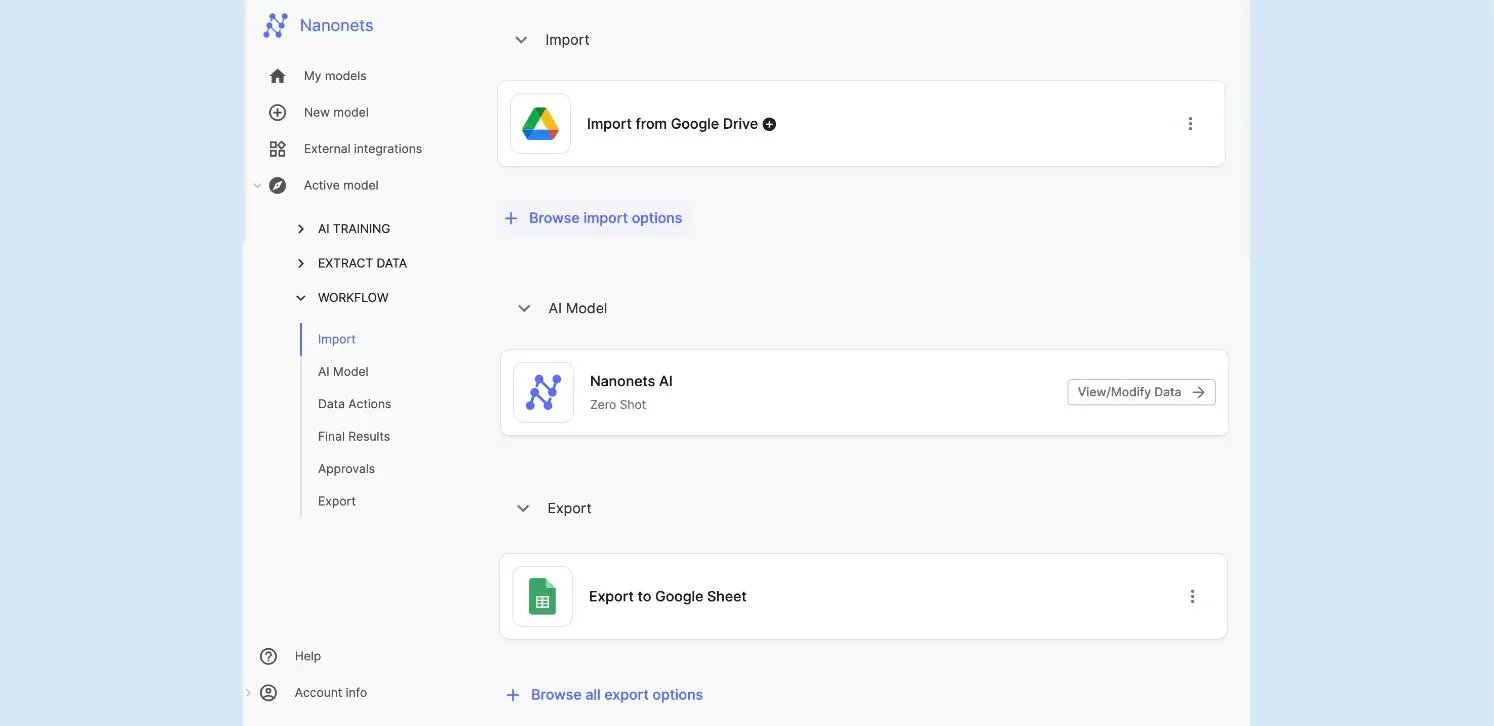Automating Data Entry in 2024
Introduction
Ever found yourself wondering if there was a magical way to transfer all these paper documents to your computer? Ever found yourself with numb hands from having to enter too much data? Ever found yourself redoing all the data entry work because you made a mistake? If you answered yes to any of these questions, you're in the right place. We have the perfect set of solutions for you!
What is Data Entry Automation?
You're probably already familiar with what data entry is, but what exactly do we mean by data entry automation? Well, data entry is typically a manual, repetitive & menial process that takes up a lot of time. There is no creativity, reasoning, or problem solving involved. Therefore, it becomes important to build an automated process around it. This process is what we often refer to as 'Data Entry Automation'.
Data entry automation refers to software-based solutions that can optimize data entry by eliminating or reducing manual processes. Data entry work can be automated with the help of easy-to-use online tools like optical character recognition (OCR), app integrations, voice-to-text, and workflow builder softwares. Such data automation software can typically extract data from PDFs, documents, images, emails or websites and present just the relevant info in a structured format (CSV, JSON, XML etc.).

Why do we need Data Entry Automation?
- Time Saving
Data is often shared among organizations in non-standard formats; and they are often filled with redundant info or data defects. Whether handled in-house, or outsourced, data entry tends to be a time consuming manual process prone to rework. - Error Reduction
A Gartner study estimates that human data entry errors in finance processes alone add roughly “25000 hours of avoidable rework at a cost of $878,000 per year”. The study goes on to show how automating data entry among other solutions can help save time & resources in a huge way! - Scalability
Businesses that deal with huge volumes of data require scaleable processes. Automating data entry helps them reduce risk, minimise cost, and scale their operations.
Enhancing business efficiency, improved data quality, employee satisfaction, competitive advantage, the list keeps going, but we think we've made our point here, so let's move ahead.
Heard enough already and just want to get started with automating your data entry processes? We make automation of data entry very easy for you for free. Try it out now!

How to Automate Data Entry? Step by Step Guide
To get into the process behind automating data entry, we will have to identify all the manual steps that we need to cover when we start automating our data entry process. Let's start by breaking down and automated data entry process step by step.

- Prepare Data
Data may come in different forms like pdf documents, images, forms, scanned files, links to websites, or even physical documents. The first step to any data entry automation process is collating the data that needs to be ingested.
Free tip: Want to extract data from a website? Here's a free website scraping tool - Extract Data
We want to completely eliminate the need of a human to read data from one data source and transfer it other, and for that, we want convert the data that we collated earlier into machine readable format. We need and editable form of the above data that both us and the machine understands. There are multiple ways to achieve that.- OCR - Optical Character Recognition (OCR) is of the most prevalent method to parse data today. It uses Machine Learning Algorithms to convert images, documents, to editable files.
Pros: Online OCR tools are easily available online, supports a huge variety of input files which can be exported to different formats
Cons: Accuracy of these tools may vary from tool to tool. You can sign up to use our advanced OCR model for free. - App Integrations - There are tools available online that can integrate with other platforms and assist with automating data transfer between them. Zapier and Nanonets are examples of such tools.
Pros: Can be very accurate if you have structured data
Cons: These tools are mostly paid, inefficient if the data you have is not structured, only useful when we want to integrate to some other app. (Don't worry, we let try out these workflows for free! Try now) - Voice to Text - Not really "automating data entry" with this, but definitely saving some energy and speeding up the process by dictating the data instead of typing it.
Pros: You tire your mouth, but your hands can relax!
Cons: Still requires human intervention, not suitable for unstructured data.
The method we recommend out of the above would be to go for an OCR tool as it is a more versatile and cost effective solution.
- OCR - Optical Character Recognition (OCR) is of the most prevalent method to parse data today. It uses Machine Learning Algorithms to convert images, documents, to editable files.
- Validate Data
An optional step for organizations to check the data accuracy and validate the data before it is exported to other applications. There are many ways to validate data, but to make the process most efficient, we recommend manually verifying data for the initial stage to gain confidence. - Export Data
This step in the data entry automation process is to send the extracted data to an appropriate destination. The extracted data, presented as a structured output (csv, XML, JSON, Excel etc.), can be conveniently exported to any place using softwares and tools available online. - Create workflow to do it in Bulk
We're focusing on automating data entry because we aim to handle bulk files and process them regularly. The final step is creating a workflow for automation, minimizing human intervention and ensuring the process can be repeated as needed. How do we create workflows to automate the data entry process? There are tools and softwares available online to help you stitch these steps together to create a workflow. Our recommendation would be the Nanonets' product since it is easy to use and integrates seamlessly with various applications, including Google Drive, Dropbox, Google Sheets, Google Workspace, QuickBooks, Slack, Excel Online, One Drive, Share Point and much more. Other paid online platform include Zapier, Zoho Flow, IFTTT etc.
Instead of searching for separate tools for each step, you can explore Nanonets' free comprehensive solution below. It's a single tool that handles all the steps mentioned above. Sign up with your business domain now!

Technologies Behind Data Entry Automation
Automated data entry softwares leverage RPA (Robotic Process Automation) & OCR (like zonal OCR) among other technologies to handle repetitive tasks & “read” documents at scale. They are accurate, flexible, scalable & fast, saving businesses precious time & resources. Due to involvement of AI technology here, it is sometimes also referred to as AI Data Entry
Most solutions available online only address a single step of the data entry automation process rather than covering the entire workflow. You can find several tools for performing Online OCR, some softwares to help you with the data entry, and some to integrate apps together. The pricing for these tools may vary depending on functionality and scope of your problem. Be sure to chose the software that fits your budget.
Want to try out a ready-to-use automated solution for data entry? Sign up with your business domain and try out our free tool now!
How do we know so much? We specialise in creating solutions around data entry, workflow creation, optical character reading, reconciliation, and more and have created tailored solutions for more than 500+ customers for the same. And this is exactly why we strongly believe that the solution we have built around automating data entry for businesses is one of the best solutions available online.
Case Studies/Examples
Almost all organizational processes & workflows can benefit from data entry automation. Here are some popular use cases
Financial and Accounting Automation
Example: A large accounting firm implemented Nanonets to automate data entry specifically for extracting information from invoices, purchase orders (POs), bank statements, and receipts. The automation of data entry here reduced their manual data entry time by 70% and allowed accountants to focus on more strategic tasks further improving employee satisfaction.
Efficient Customer Service
Example: A customer service center used data entry automation to store customer information. By integrating Nanonets with their CRM, they managed to improve response times and customer satisfaction by 40%, as representatives had instant access to accurate customer data. This shows how one can automate data entry for enhanced customer service.
HR Workflow Enhancement
Example: An HR department automated data entry from resumes using Nanonets. They were able to streamline the hiring process, reducing the time spent on manual data entry by 60% and focus on candidate engagement and interviews. Automating data entry in HR workflows significantly improved efficiency.
Business Data Reporting
Example: A medium-sized enterprise used Nanonets to automate the generation of reports from generic business data. This reduced the time spent on manual data entry by 50% and provided more timely insights for decision-making. This showcases data entry software examples for business reporting.
ID Verification and KYC Processes
Example: A financial services company implemented Nanonets for ID verification and Know Your Customer (KYC) processes. This automation ensured compliance with regulations, reduced verification times by 80%, and minimized the risk of human error. Automating data entry for KYC processes greatly improved operational efficiency.
Data Collection from Documents and Websites
Example: A market research firm automated the scraping of documents and websites for data collection using Nanonets. This enabled them to gather and process large volumes of data quickly, enhancing the depth and accuracy of their research. Automate data entry from text to streamline data collection efforts.
Automated PDF Renaming
Example: A legal firm used Nanonets to automate the renaming of PDF files based on their content. This streamlined document management, saved significant time, and improved file organization and retrieval. This is an excellent example of how to automate data entry tasks for better efficiency.
Check out the two articles below for detailed customer success stories of businesses that have used Nanonets to automate their data entry!
- Expatrio uses Nanonets to save 95% of time spent on manual data entry
- Advantage Marketing scales its business 5x times using Nanonets automation
Nanonets has interesting use cases and unique customer success stories. Find out how Nanonets can power your business to be more productive.
Key Features to Look for in Automated Data Entry Softwares
If you're looking to make the switch to an automated data entry software (like Nanonets) here are some key features to look out for:
- The capacity to classify/identify multiple forms of data & custom data
- Integrations with ERP software & automation tools like Zapier, Workato, IFTTT etc for better data aggregation
- Validation rules to alert users when data needs a manual review
- A data validation interface for manual interventions (if needed)
- Real time triggers to sync and automate workflows
- A low-code or no-code environment that doesn't require an army of developers to maintain
- Advanced AI/ML capabilities that allow the automated software to learn and get better with time
- Parse Excel, csv, PDF, images or any file type
- Data transformation workflows for data cleaning, data mapping & data merging
Data Entry Automation with Nanonets
Nanonets intro
Nanonets is an automated data entry software with advanced AI/ML capabilities. Nanonets' intelligent document processing use cases help organisations adopt intelligent automation seamlessly.
- Expatrio uses Nanonets to save 95% of time spent on manual data entry
- Advantage Marketing scales its business 5x times using Nanonets automation
Automating data entry is pretty straightforward with Nanonets. Imagine importing contact details into Salesforce or email to lead in Salesforce – automated end to end! Nanonets can do this and much more.
Choose from any of the three options below depending on your use case:
Pre-trained Data Entry Model
If you are looking to automate data entry for processes that involve invoices, receipts, passports or driver's licenses, then check out Nanonets’ pre-trained models. Each of these models has been trained on millions of documents and performs very well on its respective document types.
- Login to Nanonets - Select an appropriate pre-trained model - if none suit your use case, skip to the next method (Custom Model)
- Add the source files - upload the documents from which data needs to be extracted
- Test & verify - run the Nanonets model & verify the extracted data
- Export - download the extracted data in a structured format (csv, JSON, XML etc.)
Here’s a demo of Nanonets’ pre-trained Receipt OCR model. Notice that the “Export” option provides XML as the first choice; apart from Excel & csv.
Custom Data Entry Model
If you are looking for custom data entry requirements then build a custom data entry model with Nanonets. You can typically build, train and deploy a model for any document type, in any language, all in under 25 minutes.
- Login to Nanonets - Create a custom OCR model
- Add training files - Upload sample documents that will serve as a training set for Nanonets to understand your data entry requirements
- Annotate text/data on the files - “Teach” Nanonets' AI to identify important data (specific to your requirements) in these training files
- Train the custom data entry model - Nanonets leverages deep learning to build various OCR models and tests them against each other to pick the most accurate one.
- Test & verify - Add a couple of files to verify whether the custom model suits your requirements/use case
- Export - If the data has been recognized, extracted and presented appropriately then export the file to a convenient structured format
Here’s a demo on how to train a custom data extraction model with Nanonets. As shown in the demo above, the “Export” option will provide XML as the first choice.
Nanonets API
Here’s a detailed guide to train or build your own automated data entry software using the Nanonets API. In the documentation, you will find ready to fire code samples in Python, Shell, Ruby, Golang, Java, and C#, as well as detailed API specs for different endpoints.
Frequently Asked Questions
Is there a free way to automate data entry?
Data entry can easily be automated with the help of easy-to-use online tools and technologies like Optical Character Recognition, App integrations, Workflow tools, and more.
Is there a single software that covers all the steps involved in automating data entry?
Yes, you can use the Nanonets' tool to automate data entry processes. You can perform OCR (Optical Character Recognition) and create workflows to automate the data entry process. Sign Up and Start Automating now!
I want to automate entering data from pdf to excel. How can I do that?
We have tools that can help you extract data from pdf, and we have pre built workflow that will help you push that data to excel, sheets, dropbox, or any other place as per requirement.
Where can I find template workflows to automate data entry?
We have pre built templates that can easily integrate with multiple applications for easy imports, OCR processing, validation, and exports.



